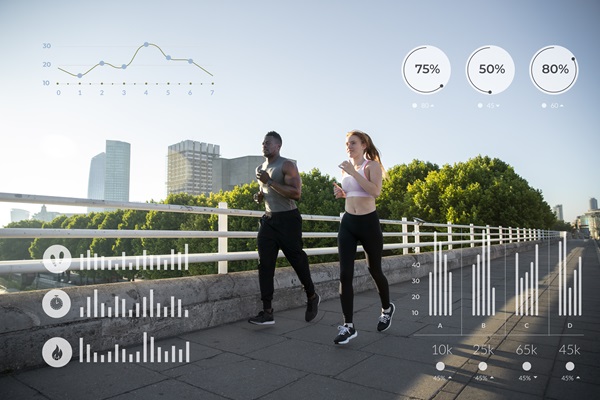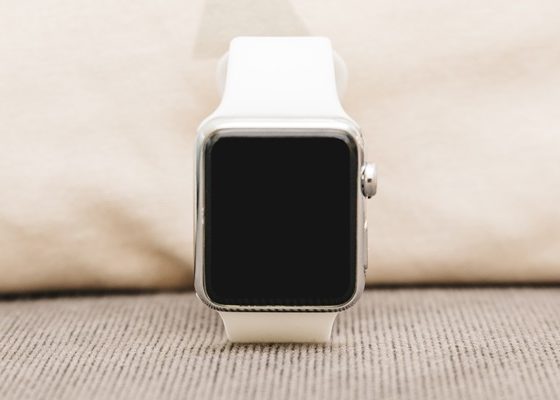The fitness tracker landscape has undergone a remarkable transformation in recent years. These compact devices, once known simply for counting steps, have evolved into sophisticated tools that offer a multifaceted approach to monitoring health and fitness. In this in-depth exploration, we will dissect the nuances of fitness-tracking technologies, dissecting the myriad features, brands, and user experiences available.

I. Introduction
a. The Evolution of Fitness-Tracking Technologies
fitness-tracking technologies have come a long way since their inception. Once rudimentary step counters, they now encompass a rich tapestry of sensors, algorithms, and connectivity options. The evolution from basic pedometers to today’s high-tech fitness companions is nothing short of remarkable.
b. The Role of Fitness-Tracking Technologies in Modern Life
In the contemporary age, fitness-tracking technologies are not mere gadgets; they are lifestyle companions. They have seamlessly integrated into our lives, helping us manage our health and stay connected. Understanding the essence of these modern-day tools requires diving into their key components and functionalities.
II. Understanding Fitness Trackers
a. What Are Fitness Trackers?
A fitness tracker is a wearable device designed to monitor various aspects of physical activity and health. These fitness-tracking technologies, often worn as wristbands, smartwatches, or discreet clips, are equipped with sensors that collect data about your movements and vital signs.
b. Fitness-Tracking Technologies Revolutionizing Your Workouts
1. Wearable Fitness Trackers
As the name suggests, wearable fitness trackers are designed to be worn on your body. These include wristbands and clips, offering convenience and comfort while tracking your every move.
2. Smartwatches as Fitness Trackers
Smartwatches, the all-in-one gadgets, have seamlessly integrated fitness tracking features. They tell the time and monitor your health, making them a versatile choice for those seeking multifunctional devices.
3. Fitness Tracker Apps
In the realm of mobile apps, fitness tracker applications stand out. These apps turn your smartphone into a fitness tracker, using its sensors to measure steps, track runs, and more. A handy option if you prefer not to wear an additional device.
III. Key Features and Metrics
a. Step Tracking
Step tracking is the foundational feature of fitness-tracking technologies, quantifying your daily physical activity. It provides a fundamental understanding of your mobility.
b. Heart Rate Monitoring
Heart rate monitoring has evolved into a critical feature, providing insights into your cardiovascular health. It can detect anomalies and help optimize workouts.
c. Sleep Tracking
The importance of sleep cannot be overstated. Advanced sleep tracking can reveal the quality and duration of your rest, aiding in better sleep hygiene.
d. Calorie Tracking
Calorie tracking goes beyond the numbers. It assists in maintaining a balanced diet and managing weight, shedding light on the relationship between intake and expenditure.
e. GPS and Location Tracking
GPS functionality can add a new dimension to your fitness tracking experience. It precisely records the routes you’ve traveled, elevating the accuracy of distance and pace measurements.
f. Water Resistance
For swimmers and watersports enthusiasts, water resistance is a must. Ensure your tracker can withstand immersion and monitor aquatic activities.
h. Battery Life
Extended battery life is a boon, reducing the hassle of frequent recharging. Longer endurance is particularly valuable for those with active lifestyles.
i. Display Options
Display types vary, from simple LED screens to vibrant OLEDs. Choose one that aligns with your preferences, whether you desire minimalism or visual richness.
IV. Brands and Models
a. Fitbit
Fitbit Charge Series
Fitbit’s Charge series is celebrated for its balance of features and affordability. It offers heart rate monitoring, sleep tracking, and a sleek design.
Fitbit Versa Series
The Versa series combines fitness tracking with smartwatch capabilities. It’s a suitable choice for those who want both health insights and smartphone integration.
Fitbit Inspire Series
The Inspire series is perfect for beginners, offering essential fitness tracking without overwhelming features, making it accessible to all.
b. Apple Watch
Apple Watch Series
Apple’s signature smartwatch boasts exceptional fitness tracking features, including an ECG sensor for heart health and GPS for precise location tracking.
watchOS Fitness Features
The watchOS operating system brings a wealth of fitness apps and health features, offering a versatile platform for those in the Apple ecosystem.
c. Garmin
Garmin Forerunner Series
Garmin’s Forerunner series is tailored for the serious athlete. It offers advanced sports tracking and precise GPS, ideal for marathons and triathlons.
Garmin Venu Series
The Venu series blends fitness and fashion, offering vibrant AMOLED displays and diverse fitness options.
d. Samsung
Samsung Galaxy Fit Series
Samsung’s Galaxy Fit series strikes a balance between fitness tracking and smartwatch features. It’s suitable for those who want a touch of both worlds.
Samsung Galaxy Watch Series
The Galaxy Watch series is a full-fledged smartwatch, with fitness tracking as one of its many facets. It offers style and substance in equal measure.
e. Other Notable Brands
Xiaomi
Xiaomi brings affordability to the fitness tracking market, with a range of feature-rich devices that won’t break the bank.
Huawei
Huawei’s trackers are known for their advanced sensors, making them ideal for health enthusiasts seeking in-depth insights.
Withings
Withings excels in minimalist design and precise health monitoring, a favorite among those who value elegance and accuracy.
Amazfit
Amazfit offers a variety of options, from budget-friendly trackers to premium smartwatches, catering to a broad audience.
V. Fitness Tracker Apps
a. The Role of Mobile Apps
Mobile apps have redefined how we use fitness trackers, turning our smartphones into multifunctional devices. They connect seamlessly with our wearable trackers and expand their capabilities.
b. Compatibility with Devices
Ensure your fitness tracker is compatible with your smartphone or tablet, allowing for smooth data synchronization and a hassle-free user experience.
c. User Interfaces and User Experience
User interfaces can vary greatly, impacting your overall satisfaction. Explore the app’s design and functionality to ensure it aligns with your preferences.
d. Syncing and Data Management
Effortless data management is essential. The ability to sync and manage your fitness data conveniently enhances your tracking experience.
VI. Accuracy and Reliability
a. Comparing Accuracy Across Brands
Not all fitness trackers are created equal. Some brands invest more in sensor accuracy and data processing, leading to more reliable results.
b. User Reviews and Testimonials
User feedback can be a valuable resource. Reading reviews and testimonials can provide insights into real-world experiences and performance.
c. Calibrating Fitness Trackers
To maximize accuracy, consider calibration. Ensure your device is properly set up and adjusted to your unique physiology.

VII. Health and Wellness Tracking
a. Heart Health Monitoring
Comprehensive heart health monitoring can be a lifesaver, alerting you to potential issues and helping you maintain a healthy cardiovascular system.
b. Sleep Quality and Patterns
Understanding your sleep patterns is the key to better rest. Advanced sleep tracking goes beyond the basics, providing valuable insights into your sleep quality.
c. Stress Tracking
Stress tracking has become an essential feature, helping individuals manage their mental well-being and reduce the negative effects of stress.
d. Menstrual Cycle Tracking
For women, menstrual cycle tracking can be empowering, providing data that aids in understanding and managing reproductive health.
e. Health Reminders and Notifications
Fitness trackers can be your health companion, providing timely reminders for medications, water intake, and other crucial activities.
VIII. Fitness and Sports Tracking
a. Exercise Modes and Profiles
Diverse exercise modes and profiles allow you to tailor your tracker to your preferred activities, enhancing its utility for specific workouts.
b. Advanced Sports Tracking
Serious athletes benefit from advanced sports tracking features, which measure performance metrics such as VO2 max, cadence, and power output.
c. Training Insights
Training insights help you optimize your workouts, identifying areas for improvement and providing recommendations for better performance.
d. Integrating with Workout Accessories
Compatibility with workout accessories like heart rate chest straps and cycling sensors can enhance data accuracy during exercise.
IX. Smart Features
a. Call and Message Notifications
Never miss an important call or message. Fitness trackers with notification capabilities ensure you stay connected.
b. Music Control
Control your music effortlessly, whether you’re pounding the pavement or hitting the gym.
c. Mobile Payments
Mobile payment features enable cashless transactions, adding convenience to your daily activities.
d. Voice Assistants
Voice assistants offer hands-free interaction, making it easy to access information and manage tasks on the go.
e. Ecosystem
An extensive app ecosystem can enhance your fitness tracker’s versatility, offering additional functionalities and personalization options.
X. Design and Comfort
a. Size and Weight
The size and weight of your fitness tracker can significantly impact your comfort and overall satisfaction with the device.
b. Display Type and Quality
Display quality varies, from simple monochrome screens to vibrant AMOLED displays. Choose one that suits your visual preferences.
c. Band Material and Interchangeability
The material and interchangeability of the band influence not only aesthetics but also comfort and durability.
d. Customization Options
Customization options add a personal touch to your device, reflecting your style and preferences.
XI. Battery Life and Charging
a. Battery Types
Different fitness trackers employ various battery types, including lithium-polymer and lithium-ion, impacting overall longevity.
b. Typical Battery Life
Extended battery life is a crucial consideration for those who don’t want to be tethered to chargers.
c. Charging Methods
Consider the convenience of the charging method, whether it’s a proprietary dock, wireless, or other options.
XII. Price Range
a. Entry-level fitness-tracking technologies
Entry-level fitness-tracking technologies offer basic functionality at an affordable price, making them accessible to all.
b. Mid-range fitness-tracking technologies
Mid-range fitness-tracking technologies strike a balance between features and cost, appealing to a broad audience.
c. Premium Fitness-tracking technologies
Premium fitness-tracking technologies come with a price tag, but they often provide advanced features and superior build quality.
d. Long-Term Value
When assessing the price, consider the long-term value in terms of durability, future updates, and ongoing support.

XIII. User Interface and Navigation
a. Touchscreen vs. Buttons
The choice between touchscreen and physical buttons influences the ease of navigation and control.
b. Menu Layout and Navigation
An intuitive menu layout and navigation ensure a seamless and frustration-free user experience.
c. Customization and Widgets
Customization options allow you to personalize your tracker’s home screen with widgets displaying the data that matters most to you.
XIV. Data Privacy and Security
a. Data Collection and Usage
Understanding how your data is collected and used ensures your privacy and security are upheld.
b. Data Encryption
Robust data encryption is vital to safeguard your personal health information.
c. Privacy Policies and User Consent
Familiarize yourself with the privacy policies and ensure you consent to data collection practices.
XV. App Ecosystem and Integration
a. Compatibility with Popular Health Apps
Integrating with popular health apps enhances the versatility of your fitness tracker and centralizes your health data.
b. Open vs. Closed Ecosystems
Consider whether you prefer an open or closed ecosystem, as it affects your device’s compatibility and flexibility.
c. Data Sharing and Accessibility
Ensure data sharing options meet your needs, allowing you to collaborate with healthcare providers or share achievements with friends.
XVI. Customer Support and Warranty
a. Brand Reputation
The reputation of the brand matters, as it reflects the quality of customer support and product reliability.
b. Customer Service Channels
Explore the available customer service channels, such as phone support, email, or chat, to address potential issues.
c. Warranty Terms and Conditions
Understanding the warranty terms and conditions provides clarity on what is covered and the duration of coverage.
XVII. User Feedback and Reviews
a. Online Reviews and Ratings
Online reviews and ratings offer insights into real-world user experiences, helping you make an informed decision.
b. Common User Complaints and Praise
Pay attention to common user complaints and praise, as they reveal the strengths and weaknesses of the product.
c. Updates and Improvements
Stay informed about software updates and improvements, as they can enhance the functionality of fitness-tracking technologies.
XVIII. Future Trends in Fitness Trackers
a. AI and Machine Learning Integration
The future promises advanced AI and machine learning integration, allowing fitness-tracking technologies to provide personalized insights and recommendations.
b. Health Diagnostics and Predictive Analytics
Health diagnostics and predictive analytics could revolutionize healthcare by anticipating health issues before they manifest.
c. Fashion and Wearable Tech Fusion
The fusion of fashion and wearable tech will result in more stylish and discreet fitness tracker designs, appealing to a broader audience.
XIX. Conclusion
a. The Best Fitness Tracker for You
The best fitness tracker for you depends on your individual needs and preferences. Consider your fitness goals, lifestyle, and budget to find the perfect companion for your journey.
b. Making the Most of Your Fitness Tracker
Once you’ve selected your ideal fitness tracker, make the most of it by using its features to achieve your health and fitness goals. Regularly sync your data, set personal targets, and enjoy the benefits of a healthier, more active life.
This comprehensive comparison and review of fitness-tracking technologies provide you with the insights you need to make an informed decision about the perfect device for your health and fitness journey. Whether you’re a fitness enthusiast, an athlete, or someone looking to lead a healthier life, the evolution of fitness trackers has something to offer to everyone.

